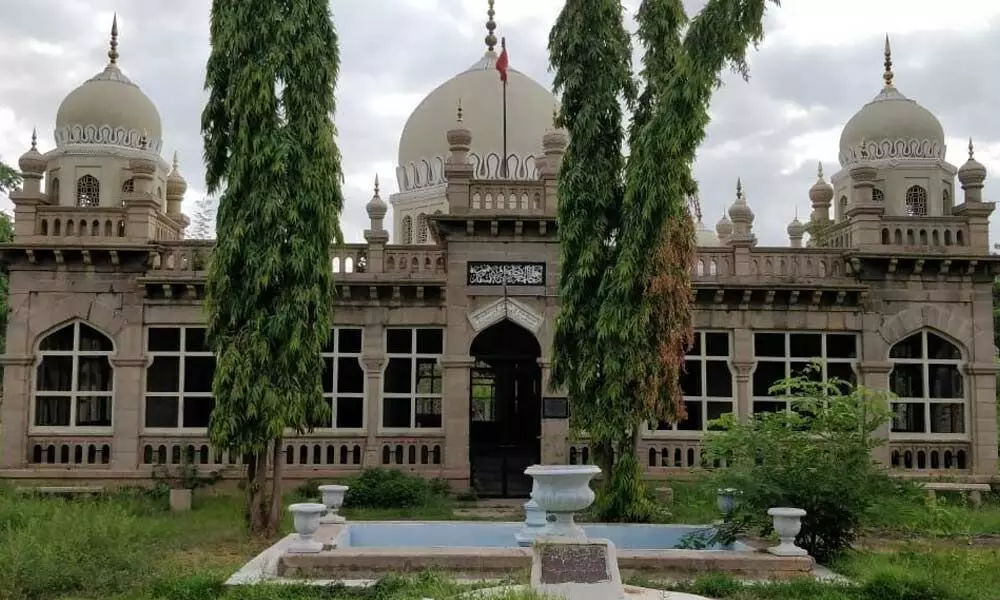Live
- Odisha BJP chief to be elected in January
- AP Home Minister Anitha alerts officials amid rains in heavy Rains in Tirupati
- Taluk Guarantee panel
- Uber Launches Uber Moto Women for Safer and Flexible Rides in Bengaluru
- ‘Fear’ pre-release event creates waves
- Champions Trophy 2025 Host Change? Indian Broadcaster's Promo Sparks Controversy
- Nabha Natesh introduced as Sundara Valli from ‘Swayambhu’
- Aamir Khan praises Upendra's ‘UI: The Movie’ ahead of its release
- Celebrations: Keerthy Suresh ties the knot with Antony Thattil
- Indian scientists develop flexible near-infrared devices for wearable sensors
Just In
Hyderabad: Taj Mahal look-alike cries for attention


Taj Mahal look-alike cries for attention
Maqbara of Nawab Fakhr-ul-Mulk Bahadur is badly neglected and in dire need of restoration
Drawing inspiration from the 7th wonder of the world, the Taj Mahal, a mausoleum built more than a century ago not only reminds the symbol of love but remains intact. This captivating structure continues to intrigue the passerby and is cynosure for those who wish to savour the old world charm, away from hustle and bustle of concrete jungles.
The historic Maqbara of Nawab Fakhr-ul-Mulk Bahadur, who was the Defense Minister during the reign of Mir Mehboob Ali Khan Bahadur, the sixth Nizam of Hyderabad state, is one of its kind in the city. It resembles the iconic Taj Mahal from the foreground. Nawab now rests with his wife and other family members for the eternity at this architectural excellence of the pure granite. The magnificent stone building was constructed in 1902 and Nawab was buried there after his demise in 1934, beside his wife.
The tomb is located on the main road at SR Nagar in Erragadda, but is still not so popular amongst the locals. The structure remains closed and not accessible to everyone. It is guarded by a strong fencing made up of iron which spikes out. "The story of the mausoleum has the resemblance with the Taj Mahal story. Nawab made the tomb in memory of his wife and used to spend every evening in this Tomb. It is one of the last Qutub Shahi architectures in modern times with pure granite," said historian Anuradha Reddy, the convener of INTACH (The Indian National Trust for Art and Cultural Heritage).
The structure that looks like Taj Mahal is constructed from granite, limestone and sand. A large beautiful dome has been built on the upper surface which is carved out of granite stone. And four small domes have been built in each corner, while each dome has been decorated with four small minarets. The entire monument is covered with granite wall fencing including a Kaman (gateway).
Anuradha Reddy says it is the last example of granite construction in modern Qutub Shahi style and known for its importance as a milestone in the evolution of tomb architecture in Hyderabad. The INTACH Heritage Award was given in year 2011 for its iconic style.
"However, the sad fact is that such a beautiful historical mausoleum has been so badly neglected and needs to be repaired and maintained. The structure which got INTACH Heritage Award in 2011 is now in a terrible condition due to lack of maintenance. The surrounding areas of the tomb have also been usurped by some occupants. The concerned officials must take action for its repair as well as to remove the illegal structures attached to the maqbara," said Mohammed Habeebuddin, a heritage activist.
Illustrious History
Nawab Fakhr-ul-Mulk-II was one of the Umra-e-Uzzam, the Great Nobles of Hyderabad, whose place was right after the Nizams and the Paigahs. He inherited his fondness for the western way of life from his father Fakhr-ul-Mulk-I, who had been responsible for the security of the Englishmen in Hyderabad, during the First War of Independence in 1857. The Nawab was known for his flamboyant lifestyle and his love for entertaining. He was also known for his kindness, and charity to the poor, regularly distribute money, goods and food cooked in his own home to the poor.
Nawab Mulk initially lived in the Asad Bagh Palace (now the Nizam College). Later, in 1870, he built the Errum Manzil palace. It is said that Nawab Fakhr-ul-Mulk and Sir Vicar-ul-Umra (the Paigah Nawab) had a competition to see who could build the higher palace. Since both built their palaces on hilltops, it ended in a tie. Fakhr-ul-Mulk built Erum Manzil, while Vicar-ul-Umla built Vikhar Manzil.

© 2024 Hyderabad Media House Limited/The Hans India. All rights reserved. Powered by hocalwire.com






